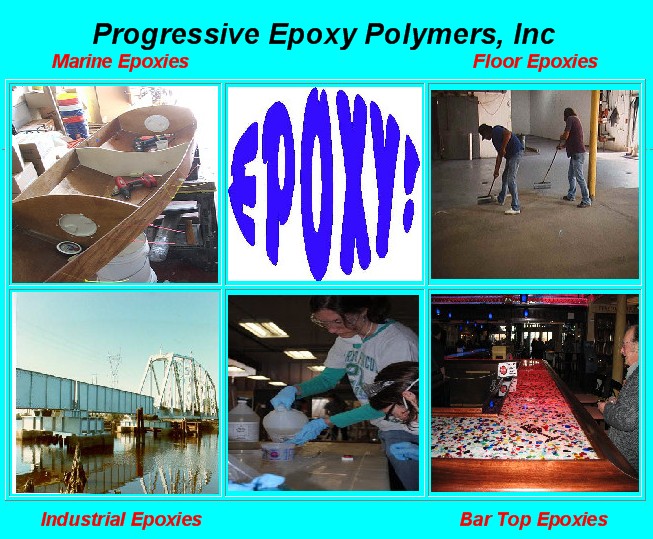
|
Read about epoxy web site fibs, half truths, fake facts, and misleading statements before you buy from any online vendor. Knowledge is power! CLICK HERE |

Epoxy specific search engine - search Epoxy
Industry specific EPOXY search engine site
CALL 603-435-7199 (or
email).
We are the only technology based coating/epoxy/resin company that actively encourages your phone calls, not just during our East Coast work hours but also after/before hours, evening, weekends and even holidays. We're available when you are. We form a personal relationship with our customers and freely share technical information, how to-advice, product information and tips-and-tricks. Speak with a non-salesman technical professional with over 25 years of experience in the resin/coating/epoxy industry (no newbie staffer on the phone lines!). Floors, tables, boats, leaks, rot repair. We handle it all! We are an 'always available,' one-on-one, technical/scientific, coating company (watch our video). We are NOT one of those fluffy/slick mass sales firms the dominate the internet selling cheap third party (made in China???), low end epoxies and coatings with no real knowledge of what they are selling and quotas to sell to as many people as possible. 603-435-7199 (east coast time).
VISIT OUR NEW INTERNET EPOXY SEARCH ENGINE - EPOXYSEACH.COM
Progressive Epoxy Polymers, Inc. is the Internet's (and probably America's) most diverse, unbiased, largest source for multi-vendor coating solutions involving epoxies, epoxy resins, and related products.
Proudly serving the commercial, marine, industrial, home, and boating markets

Progressive Epoxy Polymers, Inc. - your source for two part epoxies from Tax Free New Hampshire
Member: Internet Epoxy Confederation (IEC)
PROGRESSIVE EPOXY POLYMERS, INC.
EPOXY BASICS
1. Epoxy coatings are used because of their outstanding
chemical resistance, durability, low porosity and strong bond strength. Better
protective coatings are available but not as common, field applied, brush-on,
roll-on, or trowel-on coatings.
2. Epoxies consist of a ‘base' and a ‘curing' agent. The two components are
mixed in a certain ratio. A chemical reaction occurs between the two parts
generating heat (exotherm) and hardening the mixture into an inert, hard
‘plastic'.
3. Epoxies yellow, chalk (or more commonly least lose their gloss), in direct
sunlight (UV). The yellowing can be a real problem. For pigmented epoxies select
colors that are dark or contain a lot of yellow (such as green). Even clear
epoxies will yellow and cloud up. Often epoxies are top coated with latex or
urethanes that will retain their color and attractive gloss. This is
particularly true if color coding or matching company colors is important.
4. After the two epoxy parts are combined there is a working time (pot life)
during which the epoxy can be applied or used. Generally the pot life will be
anywhere from minutes to one hour or longer. At the end of the pot life the
mixture becomes very warm (or even dangerously hot) and quickly begins to
harden.
5. Epoxies will harden in minutes or hours, but complete cure (hardening) will
generally take several days. Most epoxies will be suitably hard within a day or
so, but may require more time to harden before the coating can be sanded.
6. In theory, a temperature change of 18 degrees F. will double or half the pot
life and cure time of an epoxy. Higher temperatures will lower the viscosity
(thin) the epoxy, but also reduce the working time a person has to apply the
epoxy. Spreading out the mixed epoxy instead of keeping it concentrated in a
bucket or container will extend the pot life.
7. Generally epoxies become too thick and cure too slowly to be applied at
temperatures below 50 or 60 degrees F. Temperatures in the 60s, 70s, or low 80s,
are best. After the epoxy has cured, it can handle temperatures well below zero
degrees F.
8. Epoxies will begin to soften at about 140 degrees F, but will reharden when
the temperature is reduced. For common epoxies this temperature is approximate
upper end of working temperature range of epoxies. Special high temperature
epoxies do exist, however.
9. By their nature, epoxies are hard and brittle. Additives can be added to
epoxies that make them less brittle, but generally at the loss or reduction of
other positive epoxy properties such as chemical resistance.
10. There are special epoxy formulations that have increased chemical
resistance, increased temperature resistance, the ability to be applied
underwater, (also
click here)
and enhance resistance to yellowing and UV damage.
We really appreciate you visiting PROGRESSIVE EPOXY POLYMERS, INC. and our web site: EPOXYPRODUCTS.COM. Take advantage of the CONTACT links on this page to ask questions about our products and/or your projects. You can stay in touch with us via our NEWSLETTER (link on our contact page) which is emailed every 6-8 weeks.
This current page is all about:
Epoxy specific search engine - search Epoxy
Industry specific EPOXY search engine site
|
|
WOW! 35% - 40% of all daily online or telephone orders are from existing customers. That's an amazing 'REPEAT CUSTOMER" number. |
|
603 - 435 - 7199 ANYTIME 24/7 FOR HELP OR ORDERS |
|
|
|
|
11. Epoxies are expensive, but there are ways to ‘water down' the epoxies with
less expensive solvents an/or non-solvent thinners. These cheaper, diluted
epoxies do not perform as well as the more expensive, unaltered epoxies. Diluted
down epoxies are especially common with ‘floor epoxies' where pricing pressures
are especially strong. To a large degree you do ‘get what you pay for'. A common
non-solvent thinner is a chemical known as
nonyl phenol. This chemical is sometimes used in small amounts to
make epoxy mixing ratios easy whole numbers. However, cheap epoxies may contain
large amounts of this inexpensive chemical. Check your epoxy's MSDS for
references to nonyl phenol.
12. Another clue of a cheap epoxy is if it requires haz-mat shipping. Generally
the better resin systems can be shipped non-haz-mat. The exceptions are special
high temperature and/or more UV resistant epoxies, which often require haz-mat
shipping.
13. Other clues of cheap epoxies include ‘induction time' (after mixing the two
components the mixture must sit for several minutes to ‘self cook' before being
applied), and crystallization of either part A or part B if left sitting for
several months (like crystallized honey, simple heating will dissolve the
crystals).
14. As they cure most epoxies ‘blush'. Blush is a waxy coating that forms in the
surface of the curing epoxy due to moisture in the air.
Visit the Epoxy Blush Page.
Because nothing sticks to the waxy coating (including paint or additional layers
of epoxy) it must be washed off. Most epoxies blush to some degree but some of
the very best epoxies do not, in fact,
some can actually be applied underwater.
15. The best time to recoat epoxy is within about 48 hours after the initial
coat. Because epoxies take days to reach full cure, a second coat applied
shortly after the first coat will partially fuse to the first coat rather than
forming a simple mechanical bond.
16. Always mix the epoxies in one container then pour it into a second container
and apply it from the second container. The reason is that mixing is never very
good at the corners, edges and sides of the mixing container. If you apply the
epoxy from the primary mixing pail you will certainly get some of the unmixed
epoxy from the bottom of the container and that epoxy will not harden.
Transferring the epoxy to a second container leaves the unmixed epoxy behind, or
blends it into the well mixed epoxy.
17. The difference between polyester (fiberglass) resins (commonly used in
fiberglass boats) and epoxy resins: Polyester resins are much less expensive,
have very strong fumes, are more porous than epoxy resins, and only sticks
really well to itself. For
anti-blister
marine barrier
coats, and bonding to wood, steel, etc. use epoxy resin not polyester
resin. Generally epoxies (which are often solvent-free) can be applied to foam
products whereas the polyester resins will dissolve these products. For more
'boating tips'
click here.
18. End users can thicken epoxy with many things, Tiny glass spheres, known as
micro-spheres or micro-balloons are commonly used. Besides thickening, their
crushable nature makes sanding the hardened epoxy easier. On the downside, they
work like tiny ball bearings, resulting is sagging and slumping. Another
thickener is fumed silica (a common brand name is Cabosil (tm)) which looks like
fake snow. About 2 parts fumed silica with one part epoxy will produce a mixture
similar in texture and thickness to petroleum jelly. Micro-spheres and fumed
silica can be combined together.
19. While floor epoxies are very common, for serious and demanding applications
the epoxy is either mixed with, or applied under and above, quartz (sand) or
aluminum oxide grains. Either way, the result is really a quartz or aluminum
oxide floor, held in place with the epoxy. The quartz, and even better the
aluminum oxide, is much more durable and wear resistant than the epoxy alone.
20. How thick should your epoxy coating be? Thicker is not necessarily better.
The paint on your office walls is probably 2-4 mils thick (1000 mils = 1inch).
Ten mils is considered a fairly thick industrial coating. A gallon of epoxy
applied at 10 mils will cover 160 square feet. That same coating, applied 1/4
inch thick, will only cover 6.5 square feet. To be price competitive with the 10
mil coating on a cost per square foot basis, the quarter inch thick coating
would have to be very inexpensive. A primary way to reduce cost is to use low
quality resins and lots of cheap fillers. As a result, the thicker coating may
be inferior to the thinner, higher quality coating.
21. Adhesion of underwater applied epoxies: Underwater epoxies generally have
good to excellent adhesion to most submerged surfaces, (i.e. emergency boat hull
repair) however, steel surfaces in saltwater environments can be a problem. Such
surfaces are often protected by a cathodic protection system. These systems use
electrical current to suppress corrosion. Dissimilar metals in saltwater also
form tiny electrical cells. Because epoxy bonding is due to molecular attraction
of charged particles, existing electrical charges, known or unknown, can
interfere or disrupt epoxy bonding. It is best to test underwater coatings for
possible cathodic adhesion problems if used in marine settings on steel
surfaces.
22. Epoxies and other paints/coatings should not be applied directly to
galvanized surfaces. Galvanization is itself a protective coating, one that
works by forming its own protective layer. Epoxies applied to galvanized
surfaces will soon peel off. If galvanized surfaces must be coated, be sure to
use an approved primer. Aluminum is also another metallic surface that epoxies
sometimes have a difficult time getting a good bond to. Aluminum quickly forms
an oxide layer (why it doesn't rust) - you need to coat it after sanding before
the oxide layer reforms. Also, many (not all) epoxies are very brittle and hard.
Many aluminum surfaces tend to flex and when they flex something gives - usually
the hard epoxy coating pops off.
23. Fisheyes are areas on a painted surface where the coating literally pulls
away for the substrate leaving a coatingless void or fisheye. Often fisheyes are
caused by surface contaminants such as a bit of silicon, wax, or oil. I have
also seen them on clean plywood where epoxies paints have been used as sealers
and the problem might be due to uneven saturation (soaking-in) of the epoxy into
the wood. Surface tension plays a big part in fisheyeing. There are some
additives that can be mixed into the epoxy that will reduce surface tension.
Likewise, on wood, applying several coats of solvent thinned epoxy, instead of
one coat of unthinned epoxy, seems to work well. Applying a thick coat of epoxy
over a contaminated fisheye surface will bury the fisheye but expect the coating
to peel away in the future. As a rule of thumb, always suspect some sort of
surface contamination as the primary cause of fisheyeing.
Pinholes are similar but caused by expanding air bubbles under the
still soft epoxy.
Coatings can fail for lots of other reasons.
24. Adding a bit of solvent to a solvent based or solvent-free epoxy is
something that most manufacturers would not officially approve of and something
that might not work with all epoxies. However, it can be done (unofficially)
with the epoxies I deal with. Adding solvent to these epoxies will: 1) thin them
out; 2) increase pot life; 3) allows them to flow off the brush/roller a bit
more smoothly; and 4) perhaps allows them to ‘soak-in', penetrate, or may be
soften, the substrate just a little bit. Not change is visible in the epoxy
unless 12% or greater solvent is added. With that amount of solvent, the epoxies
no longer cure with a glossy finish.
25. It is best to use epoxies with a mix ratio close to 1 to 1 as opposed to
something 4-1, 5-1, etc. because errors in the mix ratios can be more pronounced
with the latter. That said, no matter what the mix ratio is, some epoxies are
more forgiving of mix ratio errors than others. One ‘trick' of epoxy vendors
with odd or very sensitive mix ratios is to sell calibrated pumps that disperse
the epoxy components in exact amounts.

link to in-site search engine
Enter Your Search Terms In The
White Box Below